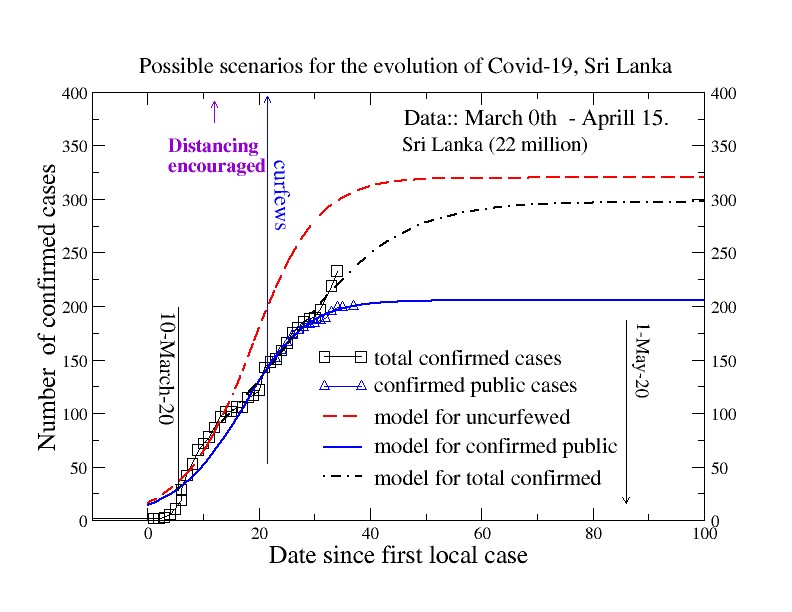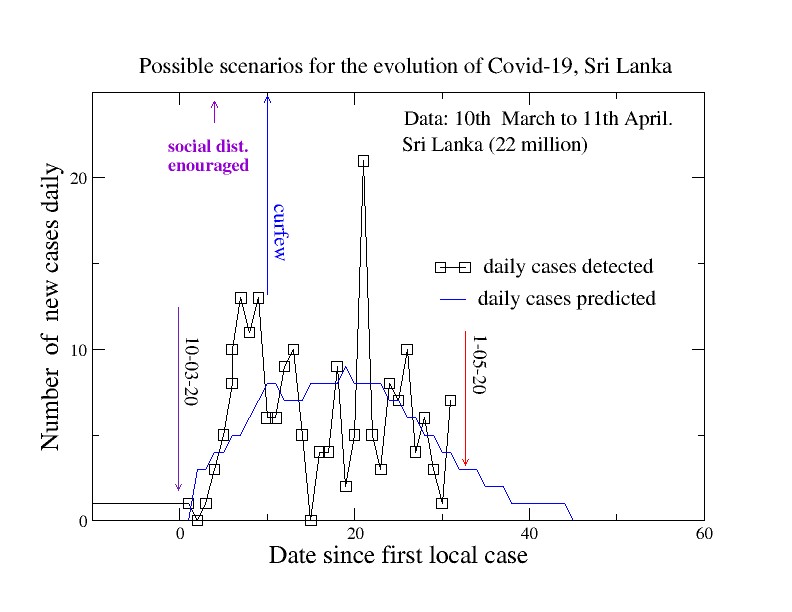The evolution of the Covid-19 in Sri Lanka and prospects for relaxing many constraints.
Posted on April 16th, 2020
By Chandre Dharmawardana
[This is a shortened version of a more technical paper, 15-04-2020]
Introduction.
An outbreak of a new type of pneumonia like disease was first reported on 31st December 2019 from Wuhan City in the Hubei Province of China. It was identifies as caused by a ‘Novel Corona Virus’ on 7th January 2020, and renamed Covid-19 on 11th February 2020. The WHO upgraded the disease to a pandemic on the 11th of March 2020.
From then on, many countries all over the world rushed to impose social distancing, lockdowns and curfews to prevent the spread of the disease. Sri Lanka’s initial official response to Covid-19 began on January 27 when quarantine measures were imposed on incoming air passengers. The first local case, a guide working with Italian tourists, was detected on 10th March, and the importance of methodically identifying transmission chains became clear. This can be more important than blindly testing populations looking for Covid-19 positive cases (see my article in the Island, 1st April).
The government at first attempted to contain the people in their homes by declaring public holidays and extending them. However, from March 18th the government began to impose curfews in Covid-19 hot spots, many being in areas to which returnees from abroad, travelers or religious teachers had arrived and irresponsibly ignored social distancing and quarantine requirements. Other who hold irrational beliefs (e.g., that the disease is caused by non-humans working in consort with Naga beings”) also ignored social distancing, wearing masks etc., and proposed inhaling herbal smoke and consuming broth made from traditional rice” for fighting the disease!
In Western countries too, patterns of transmission through human chains proved important. Also, support workers who worked in multiple nursing homes were potential carriers for spreading the disease. Nearly half of the dead in Canada from Covid-19 are in nursing homes. Such transmission chains are not normally implemented in simulation models that are used in epidemiology. Furthermore, some countries, when releasing daily data of “new cases” do not separate out cases that appear in quarantined populations from cases that appear from within the general public. New cases detected in quarantined locations do not add to the growth of the epidemic and should be treated differently in epidemiological modeling. What are labeled as “Covid-19 cases” in one country may not conform to the same labeling in another country.
Many of the epidemiological simulation models in current use are well known in the physical sciences and in ecological studies (see Bolker, Ecological models and data. Princeton University Press). They are applied to competing chemical reactions, polymerization processes, competing plant growth etc. Most of these processes begin with a period of exponential growth which gets gradually dampened and flattens out”. That is, many growth processes that are very different at the “individual level” all display growth and saturation characteristics having a universal shape. The so called logistic model is one of the simplest models belonging to this class. Here we exploit this universality and use a more sophisticated version of such a model to study Sri Lanka’s Covid-19 data.
Data analysis and modeling.
The Epidemiology unit of Sri Lanka’s ministry of Health (EU-SLH) has provided authoritative documentation in monitoring the evolution of Covid-19 via its daily bulletins. The cumulative numbers, i.e., the total confirmed cases” reported by EU-SLH data are displayed in Figure 1 (curve with squares).
The data from 10th of March to 15th April have been used in constructing our epidemiological model which can be constantly updated as new data comes in. It is clear that the trend in the data changes from 25th to 30th March, and then resumes its upward trend though with a different rate. This bi-modal characteristic is seen in the daily-change figures as well, in spite of the noisy nature of the data. This suggests two independent loci of infection, or the effect of government interventions to control the epidemic, occurring with a time lag.
Efforts have been made to account for the fact that the confirmed cases” reported daily by the EU-SLH includes new cases that appear among quarantined people. If the quarantining is effective, such new cases should not push the curve upwards” and change the final flattening trend of the curves. For instance, on the 13th of April 15 new cases were reported, when the cumulative number of confirmed cases jumped from 218 to 233. However, all 15 new cases were from those already confined in quarantine centers, and hence cannot be included as infection loci for the public. A data curve corrected for such cases is given (with triangles) in the figure, and labeled confirmed public cases”. Using these sets of data, we give our model results, and predict the long-term behaviour (asymptotic behavior) and the number of cases to expect when the curve flattens”, in each scenario.

Figure 1. Models for the time evolution of the total number of Covid-19 cases, showing projected long-term behaviour for three types of data treatment.
If we consider the data set labeled as confirmed public cases”, where Covid-19 cases arising among quarantined people are not considered relevant to the spread of the epidemic, then the long-time asymptote is about 206, and definitely below 210. If all cases (the cumulative daily totals reported by the EU-SLHD) are included in fitting the model, then the projection is 298, and certainly below 310. On the other and, if only the initial data set (prior to the imposition of social distancing and curfews) were used, the asymptote is ~325, but alternative parameter choices giving even 600 are possible. This shows that social distancing and curfews were effective in constraining the evolution of the epidemic.

Figure 2. A comparison of daily new” numbers of the model prediction and actual data.
The model can now be used to predict the daily new” numbers from
10th March onwards, and examine how well they agree with the observed data. Note that what was fitted was the cumulative daily totals, and not this differential quantity. Hence good agreement with
the general trends in the daily new” numbers is a useful test of the quality of the model. Our model reproduces the rough bi-modal character of the observed data and the general trends (Fig. 2).
Conclusion.
Assuming that that the hospital resources are able to handle even 500 cases, these studies suggest that Sri Lanka should be able to resume nearly normal economic and civic activity by the end of the first week of May, assuming that the epidemic retains the characteristics shown in the current data. The confirmed new cases are arising mainly in hotspots in six districts, while the other districts seem close to normal. Hence a graduated approach to opening the economy should be followed. Important civic activities like elections can be held while still imposing physical distancing. Sri Lanka’s economic rekindling is linked to domestic needs as well as those of its foreign trading partners.
The Covid-19 epidemic has created a situation where working online is becoming permanently institutionalized, and this is environmentally very desirable in reducing travel stress, particulate dust and combustion of fossil fuels. The re-opening should make all such desirable features a permanent characteristic of the economy.
April 16th, 2020 at 11:39 pm
Before combating this deadly virus the medics should figure out how it originated. There are theories and the world leaders like Trump and Xi are accusing each other which may even lead to a war.
A few minutes ago I was watching a video of LankaAnews which says an aircraft carrier belonging to France with 1700 sailors also has got 600 of them falling sick though it had not had any contact with outside world during this pandemic. So, if the thing goes from human to human or animal to human this could not have happened as they were in the sea isolated.
Few weeks ago there was the news that half the population of Iceland had got antibodies to Covid-19. I therefore tend to believe in the theory put forward by Prof. Chandra Wickremasinghe that this virus has come from outer space.
I also have noticed the following during the recent past:
Until yesterday I was held up in our apartment in Battaramulla and I notice the mosquito problem in that place vanished almost overnight and even in Colombo where I stay now is the same. Also I found dead cockroaches all over the place when I arrived. They live in manholes etc and were sen especially in the kitchen moving about in the night. Now, not a single of them can be seen. I heard over ITN few days ago that in some place in NCP large number of insects (kurumini) which was a problem to farmers have all died all of a sudden since Corona came to the scene.
So, can it not be that the virus has come from heaven as the prof says and after entering a living being, go on mutating depending on the ability of that being to fight it and cause problems?. May be after entering a person or community stays there until the nature itself (sun rays, gamma rays etc.) eliminate it.
April 16th, 2020 at 11:45 pm
The writer includes ‘…. inhaling herbal smoke and consuming broth made from traditional rice for fighting the disease’ in his list of questionable traditional remedies for Covid-19 infection, which he ridicules.
I have the highest regard and respect for Dr Dharmawardana, who is a world class scientist of Sri Lankan origin working in Canada. I believe he won’t take it amiss if I offer here to describe my commonsense view, for what it is worth, regarding herbal smoke, broth from traditional rice, etc. I share his scepticism about ‘… irrational beliefs (e.g., that the disease is caused by non-humans working in consort with Naga beings)’, though I have never heard this particular superstition before. What I have quoted from his article above is something very familiar to me as well as, I think, to others who grew up as children, particularly, in non-urban Sri Lanka. Incidentally, I think, Dr Dharmawardana means ‘inhaling herbal steam’ not ‘herbal smoke’? Of course, fumigating houses by burning leaves of citrus and citronella to drive away mosquitoes was also known. Anyway, when a child I experienced the efficacy of inhaling lime leaves steam (hardly bearably hot steam rising from water in which a few lime leaves were boiled) as a treatment for cold, which is a viral disease, for which no cure has been found. The steaming relieves the congestion of the nasal area. I heard a doctor explaining that the beginning part of the respiratory tract in the nasal cavity is the coolest part of the head that is conducive to the growth of the common cold germ; the hot steam kills it or weakens it.The inhaled oil in the steam must have helped too. An associated remedy is drinking a warm infusion of coriander and ginger. According to my sister, many in Sri Lanka use this concoction these days, and no doubt it will help them both medicinally, and by building morale. It helps building up immunity, according the doctor. Gruel prepared from specific indigenous rice varieties has the same effect. These are not practices of necessarily ignorant, superstitious village folk. Generations who survived in the particular geographical and cultural environment where these practices emerged and evolved have transmitted these health maintaining traditions down the ages. The unique rice varieties that are not found elsewhere than Sri Lanka are the ones that are best suited for the indigenes.
However, in the current COVID-19 context, no one offered these as permanent cures, but only as harmless relief measures that could be resorted to until better remedies are discovered or developed by scientists. So there is nothing to ridicule about them.